|
Report from
Europe
Encouraging signs for European furniture sector
The global significance of the European furniture sector,
and some positive signs for the sector after the turmoil
caused by the COVID pandemic, are highlighted in recent
reports in World Furniture, the trade journal of CSIL, the
Milan-based furniture market research organisation
(www.worldfurnitureonline.com).
In the editorial to the most recent edition (June 2021) of
World Furniture, Paola Govoni notes that ¡°the disruptive
consequences of the last 18 months are there for all to see.
A lot has changed on every level and some of these
developments could be here to stay.
At the time of writing there are encouraging signals in
Italy and most of Europe showing that the summer could
be the beginning of an exit-phase from the pandemic.
Major international economies have entered a recovery
path and the strengthening of the increasing trend resulted
in an upward revision of growth forecasts in many
countries¡±.
In a report on the Italian furniture sector, which while less
dominant in terms of production volume than in previous
years is still extremely influential for international
furniture design and branding, CSIL Market Researcher
Cecilia Pisa observes that "despite the disruptive effects of
Covid-19 both on the demand and supply side, the year
ended with a better outcome than expected".
According to Ms. Pisa, Italy¡¯s total furniture sales at home
and abroad were down around 10% overall in real terms in
2020, a significant decline of more than 25% in sales on
the domestic market in the first half of 2020 was followed
by a rebound in the second half of the year. Italian
companies managed to contain losses, some even
increasing sales due to ongoing investments in the
development of new products, in technological innovation
and the opening of new stores.
Ms. Pisa notes that a major driver of purchases of furniture
in Europe during the pandemic was renewed interest in
home renovation and improvement as the home "acquired
a new centrality both for living and working, becoming a
new fulcrum of our daily activities". Furthermore, money
saved in travel or entertainment expenses has been partly
invested in improving living spaces, positively influencing
consumption.
Ms. Pisa emphasised that there has been particular
attention paid to "the home office environment (ergonomic
office chairs, small desks and lighting fixtures), to the
kitchen, the comfort segments (from mattresses to
upholstery) and the outdoor furniture".
There is also a growing demand for flexible/transformable
furniture and sustainable solutions with a preference for
natural materials, formaldehyde-free products and waterbased
paints free of volatile organic compounds.
And, of course, the pandemic also led strong acceleration
in sales through e-commerce.
While focusing on the furniture sector, these comments
have wider significance for the wood sector, both due to
the scale of wood consumption by European
manufacturers and the importance of Europe as a market
for imported finished furniture, including from the tropics.
According to CSIL¡¯s own figures, with a market value of
nearly €100 billion (USD120 billion), Europe is the
second largest furniture market in the world, accounting
for around 26% of all world furniture consumption, second
only to Asia and the Pacific region (43%) and larger than
the North American market (23%).
In contrast to the North American market, the European
market is more heavily dependent on domestic production
with manufacturers in the region accounting for well over
80% of consumption.
Wood material is by far the most dominant base material
for furniture production in Europe. In those categories of
furniture for which material data is available, wood
accounted for 74% of the value of furniture production in
the EU28 in 2019, compared to 25% for metal and just 1%
for plastic furniture.
Eurostat data on actual furniture production in the EU in
2020 has yet to be published, but the Eurostat furniture
production index suggests that overall production was
down around 8% in the EU27 and 23% in the UK during
the year (Chart 1).
In the EU27, this followed on from a slight 1% fall in
2019 when production was already weakening in response
to sluggish growth of the EU economy and intense
competition in global markets, particularly from Chinese
manufacturers whose sales in the US market were being
diverted elsewhere due to the on-going trade dispute.
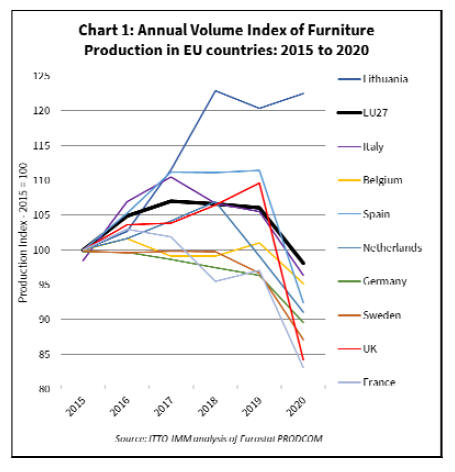
The Eurostat index shows that the production trend varied
widely between European countries during 2020, with
particularly large declines in the UK (-23%), Spain (-
17%), Romania (-16%), and France (-14%), and
moderately large declines in Sweden (-10%), Italy (-9%),
Netherlands (-8%), Germany (-7%), Belgium (-6%), and
Portugal (-5%). In Denmark production was stable in 2020
while in Lithuania, where there has been a lot of
investment in furniture production in recent years, notably
by IKEA, the production index actually increased 2%
during the year.
Eurostat¡¯s monthly furniture production index shows that
the decline in EU furniture manufacturing activity was
heavily concentrated during the first lockdown period in
March and April 2020, when there was a precipitous and
unprecedented fall (for example down as much as 90% on
normal levels in Italy), but that activity rose sharply
throughout the rest of the year. In 2021, the monthly index
shows that production in most countries has rebounded to
at least as high as the pre-COVID level and in some cases
- notably in Italy, Denmark and Lithuania - now exceeds
the pre-COVID level.
EU furniture trade surprisingly stable
While the production index gives an insight into the highly
volatile market conditions for furniture in Europe during
the COVID pandemic, the trade data seems surprisingly
stable. In terms of USD trade value, trade in 2020 was
little changed from the previous year.
This aligns with a longer term trend of relative stability, at
least when assessing annual changes in the USD dollar
value of wood furniture trade adjusted for inflation (Chart
2).
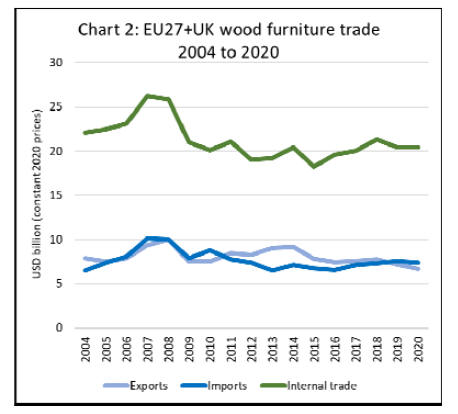
Looking from the outside, the reality is that while the
European market for wood furniture is certainly large, it
has experienced only limited growth in the last decade and
barely recovered from the large decline experienced
during the 2008-2009 financial crises.
Considering the EU27+UK as a whole, wood furniture
imports from outside the bloc were USD7.4 billion in
2020, 3% less than the previous year. This represents a
partial reversal of the gradual rising trend in import value
from USD 6.6 billion in 2016 to a decadal high of USD7.6
billion in 2019.
While imports of wood furniture into the EU27+UK have
been tending to rise in recent years, the USD value of
exports from the bloc have been sliding, a trend which has
accelerated since the start of the pandemic. In 2020,
EU27+UK exports of wood furniture to countries outside
the bloc fell 7% to USD 6.7 billion 2020. This continues a
decline in export value from a high of USD 9.17 billion in
2014 to USD7.2 billion in 2019.
Overall these trends suggest that even before the
pandemic, EU wood furniture manufacturers were
gradually losing competitiveness in global markets. The
competitive benefits of the relative weakness of the euro
against the dollar, particularly between 2015 and 2017,
and of the cost saving efforts by EU wood furniture
manufacturers in the last decade have waned.
In recent years, competition for EU-based manufacturers
has intensified from newly emerging producers in Eastern
European countries outside the EU and from Vietnam
which in the last 5 years has rapidly overtaken all other
tropical countries in the global league table of wood
furniture producing nations.
In addition to the market and logistical challenges of the
COVID pandemic, EU wood furniture manufacturers have
suffered in higher-end export markets in Asia, the CIS and
Middle East from a range of factors including diversion of
Chinese products away from the US to other markets, a
sharp fall in global equity markets towards the end of
2018, extreme weakness of the Russian rouble, and low oil
prices.
Overall, the combined effects of rising imports and
declining exports is that the slight trade surplus in
EU27+UK wood furniture trade that persisted between
2011 and 2018 became a trade deficit of USD 420 million
in 2019 rising to USD 690 million last year.
While EU27+UK furniture manufacturers have struggled
to maintain sales in external markets they remain the
dominant players in their home markets, exploiting to
good effect the benefits of close proximity and ease of
access to consumers, their depth of knowledge of fashion
trends, technical standards and distribution networks, and
their strong design skills and brands.
These long-term benefits have been reinforced by the
serious logistical problems and rising container rates
during the pandemic that have made shipment into the
region more difficult and costly.
Internal trade in wood furniture in the EU27+UK region
was USD 20.5 billion in 2020, the same level as the
previous year and only slightly less than USD 21.3 billion
in 2018 when it was at the highest level since before the
2008-2009 financial crises.
EU27+UK wooden furniture imports fell in 2020
EU27+UK imports of wooden furniture from non-EU
countries fell 3% to USD 7.4 billion in 2020 after rising
4% in 2019 (Chart 3). Imports from China, by far the
largest external supplier, decreased 3% to USD 3.66
billion in 2020, but imports from other non-tropical
countries increased 10% to USD 1.86 billion
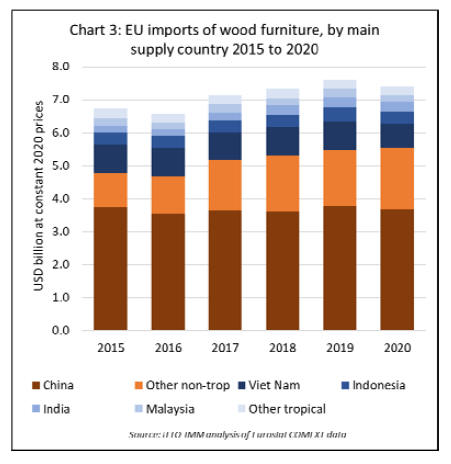
Tropical countries, for which EU27+UK imports fell 12%
to USD 1.87 billion in 2020, were the major losers, being
particularly hard hit by supply problems and rising
shipping costs during the year.
While USD value of wood furniture imports into the
EU27+UK decreased in 2020, import tonnage actually
increased, rising 3% to 2.44 million tonnes. The decline in
unit value is likely associated with a shift in the balance of
imports away from tropical countries in favour of
increased imports from China and countries in Eastern
Europe neighbouring the EU.
This probably also implies a shift in the balance of
furniture imports to include less products for exterior
applications (which still dominate in imports from tropics)
and more products for interior applications.
In 2020, import tonnage increased by 5% from China to
1.18 million tonnes and by 13% from other non-tropical
countries to 640,000 tonnes. In contrast imports from
tropical countries fell by 11% to 560,000 tonnes (Chart 4).
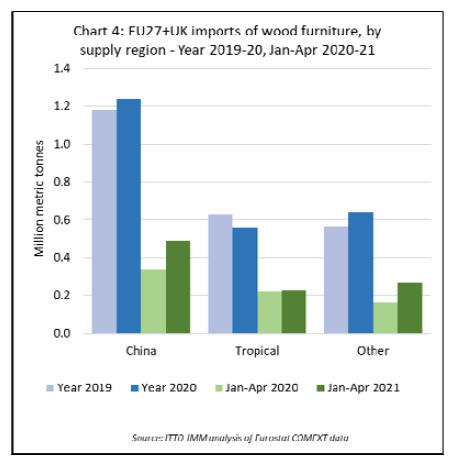
Continuing the trend of recent years, in 2020 there was
another significant increase in import tonnage of wood
furniture from several countries bordering the EU,
including Ukraine (+17% to 123,000 tonnes), Turkey
(+26% to 120,000 tonnes), Belarus (+20% to 115,000
tonnes), Bosnia (+4% to 68,000 tonnes), Serbia (+4% to
62,000 tonnes), and Russia (+29% to 40,000 tonnes).
Despite a significant decline in EU27+UK imports of
wood furniture from Vietnam last year, down 15% to
198,000 tonnes, the country remained by far the largest
tropical supplier to the bloc in 2020.
Imports also declined steeply from Malaysia (-13% to
104,000 tonnes), Indonesia (-10% to 89,000 tonnes) and
Thailand (-26% to 13,000 tonnes). Imports fell less steeply
from India (-5% to 83,000 tonnes) and Brazil (-2% to
56,000 tonnes).
Imports from Singapore nearly doubled, but from a small
base to 9,000 tonnes, due to greater availability of
containers for shipment out of the country. (Chart 5).
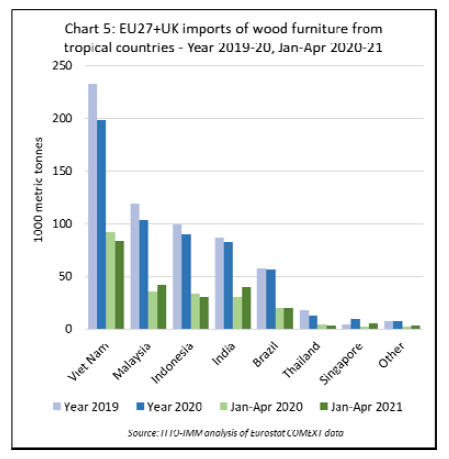
Imports of wood furniture into the EU27+UK strengthened
considerably in the opening months of this year, but once
again tropical countries lagged behind other supply
countries.
In total, the EU27+UK imported 980,000 tonnes of wood
furniture in the first four months of 2021, 37% more than
the same period in 2020. Imports increased by 46% from
China, to 490,000 tonnes, and by 63% from other nontropical
countries to 270,000 tonnes. However, imports
from tropical countries increased by only 4%, to 230,000
tonnes.
The biggest increases in EU27+UK imports of wood
furniture from tropical countries in the first 4 months of
2021 were from India (+35% to 40,000 tonnes), Malaysia
(+18% to 42,000 tonnes) and Singapore (+175% to 5,000
tonnes). Imports from Brazil increased only marginally, by
5% to 21,000 tonnes, but imports continued to decline
from Vietnam (-9% to 84,000 tonnes) and Indonesia (-8%
to 31,000 tonnes).
Much of the decrease in EU27+UK imports of wood
furniture from tropical countries in 2020 was concentrated
in the UK which a recorded a 20% fall to 192,000 tonnes
during the year. Imports from tropical countries fell less
dramatically into the other leading markets including
France (-5% to 89,000 tonnes), Germany (-3% to 78,000
tonnes), Netherlands (-5% to 66,000 tonnes), and Spain (-
4% to 22,000 tonnes).
Imports of furniture from tropical countries made some
gains in Belgium (+7% to 32,000 tonnes) and Poland
(+5% to 15,000 tonnes) in 2020. (Chart 6).
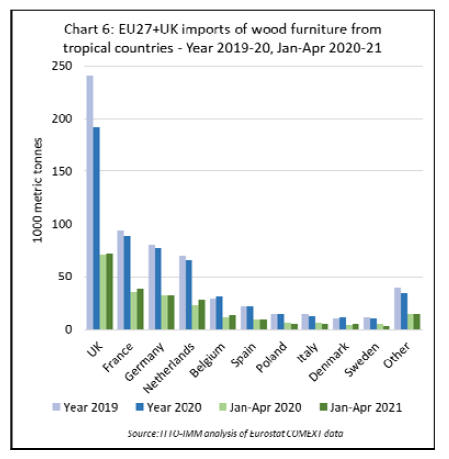
In the first four months of 2021, EU27+UK imports of
wood furniture from tropical countries recovered some of
the ground lost in the previous year, rising 4% to 228,000
tonnes.
A rise in imports was recorded in nearly all the leading
markets including UK (+2% to 72,000 tonnes), France
(+8% to 39,000 tonnes), Germany (+2% to 33,000 tonnes),
Netherlands (+18% to 28,000 tonnes), and Belgium
(+24% to 14,000 tonnes). Imports into Spain were level at
10,000 tonnes) while imports into Poland fell 20% to
5,000 tonnes.
Brexit boosts UK wooden furniture imports from China
During 2021, there are some early signs that the departure
of the UK, Europe¡¯s second largest economy, from the EU
single market and customs union at the start of the year,
may be increasing opportunities for non-EU suppliers of
wood furniture to the UK market.
The immediate impact of the pandemic on UK trade in
wood furniture was to marginally increase reliance on
imports from within the EU. In 2020, UK imports from
non-EU countries fell 9% to USD 2.4 billion while
imports from EU27 countries fell only 5% to USD 1.2
billion.
However in the first quarter of this year, immediately
following the UK¡¯s departure from the EU single market,
UK imports from outside the EU surged to over USD 800
million, nearly 40% more than the same period in 2020.
Meanwhile imports from the EU increased by only 4%.
Nearly all the gains in UK imports in the first quarter of
2021 came from China which alone accounted for 60% of
all UK imports from non-EU countries.
Consolidation and reorganisation amongst world¡¯s
largest furniture manufacturers
The global furniture sector is renowned for being
relatively fragmented, dominated in most countries by
large numbers of small and medium sized enterprises with
a relatively low degree of concentration.
But that is not say that there are no significant large
companies (IKEA immediately comes to mind) nor that
there has been no consolidation in recent years.
This is immediately apparent from the March 2021 edition
of the CSIL report on the ¡°Top 200 Furniture
Manufacturers Worldwide¡±. The report shows that the 200
largest furniture companies have a total turnover of over
USD 160 billion of which nearly USD 100 billion is
related to the furniture sector, accounting for about 20% of
world furniture production.
Together the top 200 furniture manufacturers employ
about 740,000 people and are headquartered in 30
countries. Nearly 45% of the Top 200 are headquartered in
the EU, 20% in North America, 30% in the Asia Pacific
region, and 5% in Russia, Turkey, South America, the
Middle East and Africa.
According to CSIL preliminary estimates, world furniture
production was worth about USD 422 billion in 2020, 7%
less than in 2019. The Top 200 companies appear to have
performed relatively well compared to the wider sector in
2020, with turnover falling less than 2% during the year.
This is linked to those companies¡¯ larger financial
resources which allowed quicker re-alignment of business
strategies, development of new on-line sales channels, and
repositioning of their supply chains.
According to the CSIL report, the relative performance of
the Top 200 companies has been significantly affected by
lockdown policies which have varied significantly across
countries, production segments and retail activities.
Companies have been affected to varying degrees by store
closures and delivery delays. To mitigate risk in the future,
CSIL suggest that large furniture companies will diversify
their supply bases, reduce dependence on single suppliers
and source from a wider range of locations.
CSIL note that a strategy of manufacturing location
repositioning has been accelerated in recent years, driven
by the increasing need for flexibility and to reduce the
time-to-market and minimise overall costs, including
production, tariffs, and transportation.
About half of Top 200 companies now have
manufacturing activities outside the country where their
headquarters is based. Companies that have gone furthest
in shifting part of their production activities abroad are
those headquartered in Europe (40%), followed by those in
Asia (30%) and North America (nearly 30%).
Preferred countries for investment in furniture
manufacturing by European companies are across Europe
(mostly Eastern European countries), followed by the Asia
Pacific (in particular China and Vietnam) and North
America (mainly the USA for office furniture production).
Almost all Top 200 companies headquartered in Asian
countries that have operations elsewhere have
concentrated on opening plants in other Asian countries
(notably Vietnam, Thailand and Malaysia).
However some more export-oriented manufacturers have
also opened facilities in North America (particularly
Mexico and the USA) to reduce time to market and
overcome the recent trade tensions between the US and
China (and other Asian countries).
The majority of North American companies that have
established production activities abroad have chosen to
open facilities in Mexico and to a lesser extent in the Asia
Pacific region (particularly China).
CSIL note that mergers and acquisitions (M&A) activity
has increased amongst the Top 200 companies. Around 30
M&A operations were identified between 2015 and 2016
rising to over 60 between 2017 and 2017. Much of this
activity involved US companies acquiring other US firms,
but Chinese firms were also involved in several large
investments, mostly of foreign companies and particularly
in Europe, to increase sales in some key markets and/or
expand their manufacturing capacity.
All CSIL reports can be purchased online and downloaded
from: www.worldfurnitureonline
|